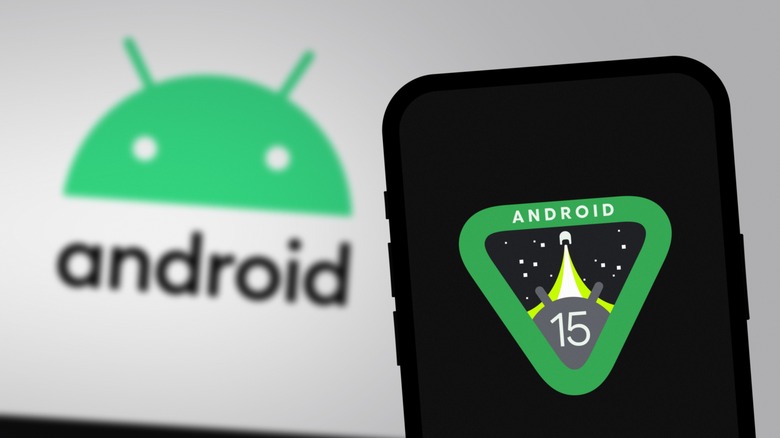
QubixStudio/Shutterstock
Almost 16 years into the Android operating system’s existence, the release of Android 15 is upon us. Though Google has long since stopped using alphabetically sequenced dessert/confectionary-themed nicknames for each version in any kind of prominent way, they still exist as internal code names. Because those code names arrived more often than each full version number in the early years, those code names are 22 letters deep into the alphabet instead of 15, making Android 15’s dessert name «Vanilla Ice Cream.» That sounds delicious, but just as tasty are some of the new features that Google is building into the 2024 version of its mobile operation system.
The most notable of those new features cover a lot of different territory. A bunch deal with security, both in terms of nuts-and-bolts device security and providing the user with tools to avoid social engineering. Privacy-conscious users who have to share their phones will also be getting a new way to designate certain apps more private than others. More connectivity options appear to be coming, especially for those who travel to remote areas, and some basic quality of life features are getting some significant improvements, as well. That just scratches the surface. though. Let’s take a look at five of the new features that jump out as making a big difference.
Satellite messaging

Mariana Serdynska/Shutterstock
As much as smartphones have changed our lives and kept us connected almost everywhere we go, they still have their limits. But they still have their limits, with gaps in coverage, especially in remote areas, and there’s just one way to fill that gap: Satellites. Apple’s iPhones added satellite support first, initially for emergency roadside assistance. This made sense in that they were trying to limit bandwidth usage to only pre-selected messages in emergencies, but soon, with iOS 15, satellite access will be extended to iMessage and SMS. That’s not 2024’s only mobile OS refresh adding satellite messaging support, though, as Android 15 will also bring it to carriers and handsets that have the proper hardware in place.
There’s an important caveat: The new satellite menu has only shown up so far on Pixel phones from the last few years that are connected to T-Mobile and installed the Android 15 beta. This could change before the final release of the OS update, though. That’s important because it had already been hyped up that T-Mobile’s satellite coverage worked with all 4G LTE-capable phones as part of T-Mobile’s partnership with Elon Musk’s Starlink. Under their «Coverage Above and Beyond»https://www.slashgear.com/»Direct to Cell» program, Starlink’s satellites appear to T-Mobile phones as regular 4G LTE towers, so any LTE-capable phone should support using them. With Google having not said anything official about this yet, it’s unclear if this is actually tied to the T-Mobile/Starlink team-up or if it’s more for something like AT&T’s upcoming supplementary satellite coverage.
Anti-theft features

Prostock-studio/Shutterstock
One particularly interesting suite of new features in Android 15 comes in the form of Google’s new anti-theft measures. These take a bunch of different forms, some of which seemed designed to deter thieves once they become aware that these new features are commonplace among Android owners. For example, there’s Theft Detection Lock, which is designed to detect common «snatching» motions used by thieves to grab your phone and then the phone’s acceleration as the thief tries to escape. If the phone detects such a series of motions, it immediately locks down your phone. To sweeten the deal, this isn’t just going to be in Android 15: Phones running OSes as old as Android 10 will get it via a Google Play Services update.
Other new anti-theft features coming in Android 15 may seem familiar to the anti-theft features on Samsung Galaxy handsets, as they’re fairly similar to what Samsung had already added to Android themselves. This includes factory reset protection, making it so that your phone can’t be reset — most thieves want to sell the phone, after all — without logging into your Google account or using your lock screen code. Google is also updating the Find My Device settings so that turning off the feature requires your unlock code. The same goes for increasing the length of the screen timeout period. Using your biometric unlock will also become a requirement to disable these anti-theft measures or change your PIN.
Private Space
Way back in 2012, ABC’s «Shark Tank» featured a pitch for CATE App, a mobile app that allowed you to create a blacklist of contacts that you could prevent from popping up in your notifications if they texted you. Though marketed to those cheating or accused of cheating on their romantic partners, it was intriguing from a privacy point of view. Regardless, it never took off and quickly disappeared. Similar functionality, though, is now coming to Android 15 in the form of what Google is calling Private Space.
Private Space will show up as a lock in the App Drawer and it will let you silo off various apps that you want an extra layer of privacy for. You can also make that lock disappear and make it so your phone requires using the App Drawer search bar to find your Private Space instead of making its existence clear to anyone with access to your phone. Entering your Private Space will require entering a second PIN distinct from your device PIN. Moving certain apps there makes it so that its notifications won’t pop up unless you’ve unlocked the Space, so if there’s anything sensitive that could pop up in a particular app, this makes it safer to share your phone. Google lists banking and health apps as the obvious use cases, but it could be useful for anyone with privacy considerations. A journalist, for example, could move Signal to Private Space for an additional layer of security over their encrypted messages.
Better fraud and scam protection
One of the more eye-popping new features for Android 15 shown off during the keynote at Google IO 2024 was an improvement to the platform’s scam call detection. In addition to the existing spam call detection and blocking functionality, Android 15 adds the ability to use the Gemini Nano on-device version of Google’s Gemini AI language model to listen in on calls in real time and detect common scams used by fraudsters. «On-device» is key there, because in theory, that should satisfy some privacy concerns, but Google’s past history of privacy gaffes makes it so that there will probably always be some level of concern about leaving the feature on. For your older, less tech-inclined relatives, it could be incredibly important.
Google also announced that its on-device AI will be employed to «analyze additional behavioral signals related to the use of sensitive permissions and interactions with other apps and services.» If such behavior is detected, Google Play Protect can send the app in question to Google for review and take steps to warn the user or outright disable to app if it’s verified that there’s a problem. In addition, Google will be taking steps to prevent screen sharing social engineering attacks. Notifications containing one-time passwords will now be hidden from notifications, usernames, passwords, and credit card numbers will automatically be hidden from anyone you share your screen with, and you’ll be able to screen share a single app instead of having to share everything that appears on your phone.
Loudness control

Just dance/Shutterstock
Unless you’re a pretty big audio geek, the following statement may come as a shock to you: «Volume» and «loudness’ are not the same thing. Volume refers to the actual scientific measurement of the quantity or power of sound, while loudness refers to how your brain subjectively perceives that sound. This is why the overuse of dynamic range compression in the mastering of digital music became known as the «Loudness War» and not the «Volume War.» CDs have a hard limit on maximum volume, so their volume can’t go past a certain point, but minimizing the volume variances between sounds will make a track feel louder. It’s the same reason that TV commercials and some video ads online feel much louder than the programming they’re inserted into.
Android 15 seeks to resolve many of these loudness issues by adopting CTA-2075, the Loudness Standard for Over-the-Top Television and Online Video Distribution for Mobile and Fixed Devices. According to Google, under this standard, Android devices will factor in what it knows about the headphones or speaker(s) you’re using and «loudness metadata available in AAC audio content» to automatically tweak the dynamic range compression so that you’re not hit with ear-splitting loudness. Google tells developers that they need to include the aforementioned metadata in all of their AAC-encoded audio going forward to get this to work, so it looks like it won’t work on everything right away. There’s still plenty of content out there with audio encoded in MP3, Vorbis, or AC3, after all.